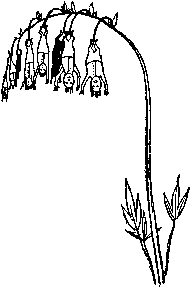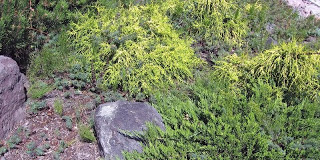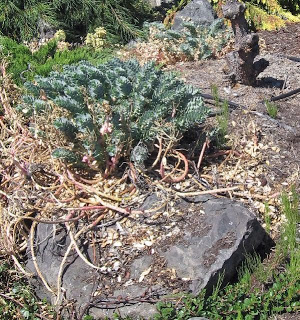“Very entertaining! The belts that you propose have a lot to offer — your descriptions of their progression are not only entertaining, but also very logical.
I have similar issues with much of the Master Gardener program. It is interesting that it began in Washington State and, not that long ago. Here in my County, its main purpose seems to be to help people who have recently arrived, make friends. The emphasis is not as much on gardening as it is on social interaction. The proof of this is that so few of the people, who have joined, remain members for very long. Typically, a person joins, is active for about three years and then drops out. They get what they wanted or needed, primarily making a few friends, plus the side benefit of learning a little about how to garden in our climate. and then leave. You would be amazed at the total number of people who have gone through the local Master Gardener program in our county. (This holds true for our Bonsai Club as well!)
Delusion has always, and will always, play a major role in our culture. We delude ourselves into buying something, by wanting to believe it is something better than what it is. It is much easier for the overseers of the Master Gardener program (the County Extension agents) to get new members by turning new members into “master gardeners,” rather than what they really are, something more accurately described as either “novice gardeners,” or “amateur gardeners.”
There really should be nothing wrong with being a novice. But for Americans there is, sad to say. In some other countries, the title of “amateur” is held in much higher esteem than it is here. In England especially, some of the most knowledgeable people in a field are the amateurs. Although he was a fictional person, Sherlock Holmes, makes a good example of the sort of “amateur” that the British place in high esteem.
I would make a guess that most of the people in the general population know even less about gardening than the average Master Gardener. And for them, a person calling himself or herself a Master Gardener does not look ridiculous. An indication that this is true, is that the Master Gardener clinics that are held every Saturday actually do get a stream of people needing help. The general population does not consider “Master Gardener” as ridiculous a title as do you or I. You and I might know that the so called expert help at those clinics is sometimes way off the mark, but for someone who knows even less, it may not appear so bad.”
cheers, xxx
“You and I might know that the so called expert help at those clinics is sometimes way off the mark, but for someone who knows even less, it may not appear so bad.”
You and I have both seem how far off the mark some of them are. I have often been left speechless at hearing the manure droppings being handed out as pearls of wisdom. I corrected a few now and then, and the speaker looked down her nose at me and said, but “I am a “Master Gardener.” I responded … “And you are delusional!”
That said, I would throw many Nursery employees and landscapers in the same boat. I responded to follow the writers comments with my own.
As for the “moving through ” the program to simply suck out what one can … we have the very same in the Bonsai group. One lady came for a year, and brought in a plant every month, all to be worked on by her mentor. When all of her plants had been worked on, she quit. All groups (including the Master Gardeners,) have members who fit that bill.
I must caution that cynicism with the thought that although the former post was a kaopectal exercise of the night, it may have some truth in it. Many clubs including the former have a difficult time in retaining, much less recruiting members. They join and leave after a year.
We assume that they have simply sponged off what they need and so drift away. It might well be that the “White Belt” neophyte, (a terrible Ann Lovejoy description) simply decided that they had a black thumb after all. Or in the Bonsai world, that they had killed off enough of their favorite trees to begin worrying about their karma. Gardening of any sort is difficult, and without enough of a buddy system, many just quit. My quirky idea actually has merit, as providing reward to achievement does to any endeavor.
Having to buy new colored Gi’s would be very expensive, so Judo and Karate devotees had a brainwave. Simply color the belts differently. Many suspect that the “white” to “black” may also have simply become a matter of lack of washing. Wearing a different “colored” badge, like the under washed belt, would be far simpler and hygienic, much like Scout merit badges and sashes.
For the moment, I cannot lampoon my Bonsai members in the same way. We have, I suspect four black belt members, but they are very polite and do not push their weight or expertise, at or over you. They are much Tai Chi. An absent black belter, is missed by some of the members. Some of that is “prestige.” did you know that the Dungeness Bonsai Society has ( ) as a member? It has been over a decade and perhaps he has changed. Like leaves dropping from branches, we all need new beginnings.
The email from another Nursery was timely as I was going to edit that post to include my own irks for Nursery employees. I had forgotten to upgrade “belts,” say if the Master Gardener had taken a Pest Advisers course.”
In the Seventies, our Nursery in Santa Cruz had some 11-13 people. Nine had C.A.N. certifications, and I was on the committee that created that test. To my chagrin, my own assistant-manager failed it the first time around. At this stage in my life I suspect I would fail as well. We also had three employees’ with Pest adviser licenses and two with Applicator Licenses.
On the Olympic we have a few brown belt Nursery-persons left. Most like Seauim Rare Plants have gone mail order.. Personally, I have known a few black belts such as the Kruckenbergs and Nevin Smith of Watsonville. Both, would be a good examples of the Darth Vader black belt.
LANDSCAPERS! I am totally outraged with the group in general. All of my customers are talented and dedicated gardeners but are relatively new to the Pacific Northwest. Their landscapers put in excellent looking designs, but they are full of flaws and invasive plants such as Euphorbia, Phygelius etc. They planted large trees four feet away from the house and put in plants that would need constant pruning back, such as the common Escallonia, rather than putting in the dwarf form.
Not only is this costing those customers much loot in hiring ME to prune them TWICE every year, but I also need to dispose of them, which is costly. I estimate that 75 percent of my work in one of these gardens has been in the eradication of these mistakes. That is a very costly edit! My own bank is a good example!
The nice looking landscape above is at the new First Federal Bank of Sequim (the closeup picture above) is beautiful to look at from the street, until you get in its face. One then sees that it is full of horsetail and that the plantings are being overwhelmed by euphorbia. I even commented on the sad state of their landscape when I opened up the account. The lady said, funny you said that; another one of our customers said the same thing. Perhaps it was a Master Gardener.
It is very sad that landscapers do their installations with no concern about future up-keep or the cost of it. Neither did any of them offer to do a maintenance contract. They put in what they could easily get, or had extra of. Even worse they often plug in way too many plants, as the more stuck in, the more they get paid. The nurseries supplying the plants are always willing to oblige. The final failing grade for the Nurseries, being — mislabeled hardiness labels, the selling of invasive plants and assuring people that questionable plants are hardy. Even brown belted Nurseryman are guilty of that!
This winter was a moderately bad one. I have seen much worse. Nearly all of my gardens had costly damage. My advice! Trust none of the above and do your own research. If you do not ask the questions, or do your research before hiring or buying, you can get yourself into years of costly labor or plant replacement bills. A a Bonsai member added in my Bonsai blog, …” you rejoice about them twice: first when you establish them, and next when you succeed in getting rid of them!”
One last thought. The reason that these people do these ghastly things is often because of “appearance.” If the landscaper brought and installed the same 20.00 dwarf plant, instead of the super-sized version, you would squawk at that puny critter! The typical homeowner wants instant gratification and usually that is what is supplied. Three years later, they discover the pain for what they have bought.
That is no excuse, but I have been down the sub-contract road and have seen customers who could spend 30,000 dollars in plant material and balk at paying for 500.00 dollars of soil amendments, or raising the soil level above the clay. As a result, the landscaper plants into pure local clay. Five years later they die and the contractor is off the hook, or has left town!
SIZE for bucks was always the biggest issue. I lost one job to a local when I refused to plant a FOREST of Douglas Fir (against covenant height restrictions) on a 12,000 ft. lot, as well as being over a septic field. Another landscaper, stepped in, planted the owners wishes and even added a Giant Sequoia. Go Figure!
My own advice comfort level would be in descending order.
Good books or magazines about gardening.
State Certified Nursery employees
Master Gardeners — many nursery employees (nearly equal)
Internet blogs such as this and eBay.
T.V. or radio plant guru’s such as the Martha Stewarts. BBC Gardeners World exempted.
Most “hired” expert Gardeners. “Have secateurs, will travel.”
Landscapers
Check out the maintenance that the gardener does for this landscape. Simply Dogpatch! These other Euphorbias need their seed heads cut back ALL THE WAY to the plant, furthermore they were not cut back until they had seeded. This second year weed plant will now appear in droves throughout the conifer landscape — and they are near impossible to weed out!





Now I understand why you were so upset with the whole garden master issue. I agree – there should be more restrained control over the education and titles.
I can assure you that we have the same problems with landscapers here in Sweden. At work I often see the waste of plants and lack of knowledge when landscapers have done their job. I scratch my head and try to solve the mess. Last – An avenue of trees planted along a whole street only three meters from the appartment buildings. Did they even choose the right habitus of the trees – like column? No they choose the most wide growing variety of that spieces. The rescidents have their balconys in the canopy. Who gets the complains and have to try to prune these poor trees? Not the landscaper but the gardener. Oh, that felt good to get of my chest 🙂
Thank you so much Charlotte. I hope you post it on the Google page.
One neglected item being MONEY! Landscapers are all too often in it for instant gratification. (Customer is to blame for this as well.) The payment check is taken and the future problems which can be IMMENSE are put off. Those Cedars planted 3 feet from the house will have to be taken out and now they are worth hundreds of dollars not just the initial cost. In fact the removal cost will be in the hundreds!
As you suggested the wrong choice of trees will affect sidewalks, streets and power lines. All meaning CITY upkeep and even gutter cleaning from drainage systems that get clogged up with Sycamore Maple tree leaves. One of my WON battles with the local city planning department. I got them to substitute columnar ornamental Pears.
Hi Janice,We have several good cioechs for winter hummingbirds. The royal grevillea, (Grevillea victoriae) has nice, grayish evergreen foliage and spidery orange red flowers fall and winter. Grevillea Porrinda Constance’ is similar in flower, but smaller, with narrow leaves. Winter honeysuckle (Lonicera standishii) is a mostly deciduous shrub with white lemon-scented flowers December through March. The winter-blooming camellias (mostly C. sasanqua) are great landscape plants that always please hummingbirds.